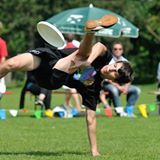Kick brushing, much like all of freestyle, is an art form. After getting the basics you are ready move on to harder and more exciting kicks. It is my recommendation that even if you have not mastered the basics you should try trick kicks. In my experience I have found that trying things beyond your ability often solidifies the ability you have and accelerates your growth as a freestyler.
Outside Heel kick:
The outside heel kick is rather simple IF you hit the disc correctly. To perform this kick set the disc on an angle to your right or left side. (clock) Most commonly, this kick is done with the right foot. You will want to set the disc about shoulder height. Rotate your knee so that it points down toward the ground. This will bring your foot up towards your head. The outside of your foot is now facing forward. With the outside of your right foot touch the disc on the outside rim at four o’clock. With your left do the same thing only hit the disc at seven o’clock. Now, if you are brave you can change the angle. Hit the disc on the bottom of the rim at four and it will change. Experiment with it and you will be able to change the angle a little or a lot. Some people change the angle off the throw. It is best to attempt this with high angle.
Leg Over Kick:
The leg over kick is all about timing. It, in essence is just a regular kick. If you set a disc on a high angle in front of you, let it come down toward your foot like a regular kick brush. Moments before you are about to kick the disc jump up and kick your opposite leg over the disc then kick the disc with the intended foot. That’s it, nothing special here excepting the timing. That itself is rather hard.
Sole brush:
The sole brush is done with the sole of your foot. Hence, Sole brush. This one can be hard. It requires a bit of flexibility. Set the disc into the wind about head height directly in front of you. With your toe pointed, swing your foot up in the air, in the direction of the spin. Hit the disc just below the ball of your foot on the rim at about five o’clock ( for clock). The disc should end up in front of you.
Behind The Leg Kick:
The behind the leg kick can be done two different ways that I know of. One is with the sole of your foot, and the other is the top of your foot. With clock spin it is easiest to do this kick with your right foot. Set the disc to your left on an angle. Let it drift down towards the ground and kick with the top of your foot, behind your left leg at six o’ clock or so. The disc will either go up and to the right or straight forward. It depends on where you hit it. I find that depending upon the wind it is sometimes easier to jump then kick. Be careful not to kick your leg out from under you.
If you want to kick it with the sole of your foot, set the disc the same as aforementioned. Instead of just kicking behind your leg you can twist to the right swinging you right foot down with your toe pointed toward the ground. Hit it at five or six and there you have it. You don’t have to spin, yet I find it easier.
Inside kick brush:
The inside kick brush is dependant mostly on angle. First you will want your back to the wind. Next set the disc, from a rim delay, on a steep angle with the nose pointed towards the wind. . (Maybe sixty degrees, it depends on the wind) The set should be near the side of your body that you wish to kick with. Then give it a kick at six or so in the direction of the spin. Watch your face, a bad hit can result in a fat lip. You don’t usually have to hit it very hard a light tap will do the trick. I find that pointing your toe will help in gaining control. If you would like to practice on your own without a rim set you can try a two handed throw set. It works well.
There are many more trick kick brushes that can be learned. Practice and experiment. Much like all freestyle there are more ways to do it than have been invented.
Also, watch film there is tons to be learned in the playback.



